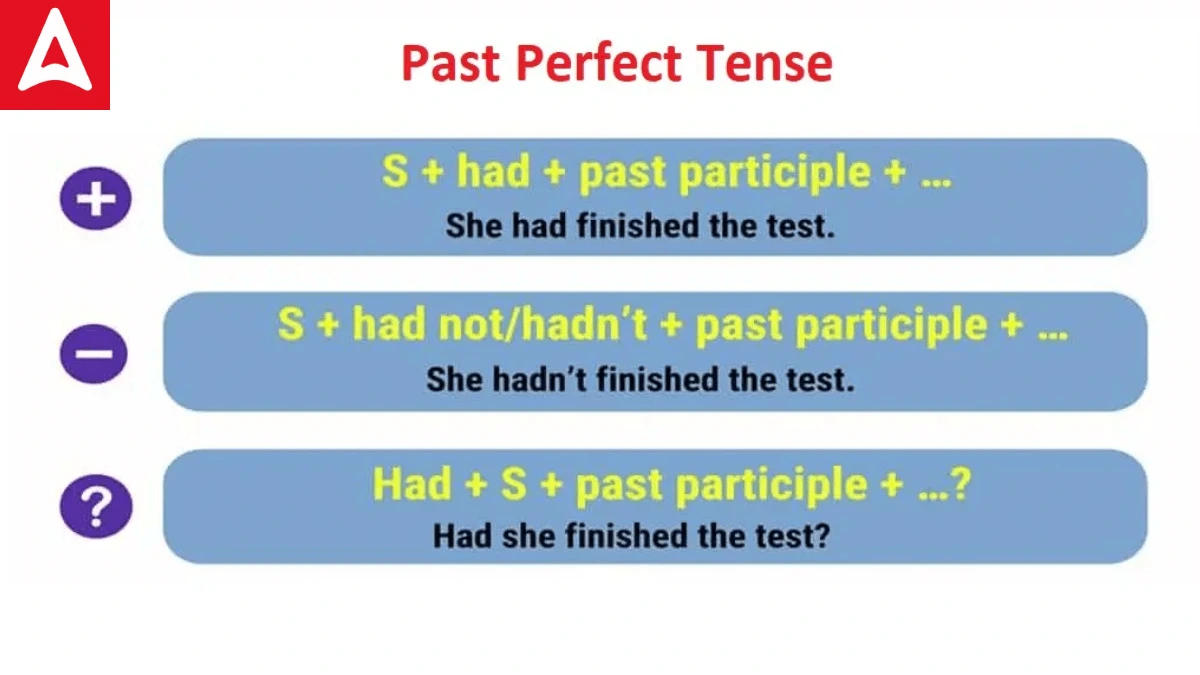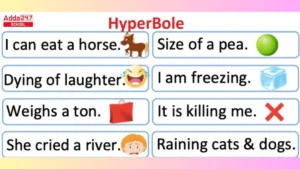The past perfect tense indicates activities that occurred before another past occurrence. It is frequently combined with adverbs or adverb phrases, such as by the time and before, to clarify a sequence. The past perfect tense is also called the pluperfect. The use of the past perfect (had left) in partnership with the simple past (arrived) indicates that two events occurred in the following order: First, she departed. Then he arrived.
Past Perfect Tense
The Past Perfect Tense differs slightly in sentence structure and usage from the Simple Past Tense and the Past Continuous Tense. The Past Perfect Tense clearly indicates that an action occurred before another action in the past. The Past Perfect can also be said to represent past actions that took place in the Past. Now let’s look at the definitions of the past tense in various dictionaries.
Past Perfect Tense Definition
Check the definition of the Past Perfect Tense as per various dictionaries below.
The Cambridge Dictionary defines the Past Perfect Tense as “a verb form used to indicate that another action has already been completed when another action is taking place.”
The Oxford Learner’s Dictionary defines the Past tense as “a verb form expressing an action completed before some point in the past, formed in English using had and the past participle”.
Another definition of past perfect tense in the Merriam Webster Dictionary is: According to this, the past tense is “a form of a verb used to refer to an action completed at a specific time in the past.”
The Collins Dictionary does it a little differently. According to them, the past tense is “a tense denoting the completion of an action or the termination of a state before a certain or implied time in the past”, and the tense can also be called by another term i.e., ‘pluperfect.’
Past Perfect Tense Formula
The general formula of the Past Perfect Tense is given below:
Subject + had + past participle (third form of the verb) + rest of the sentence.
Past Perfect Tense Structure
The formation of the past perfect tense can be analyzed with reference to affirmative (positive), negative, interrogative, and negative interrogative types of sentences. Have a look at the table given below for a better understanding.
Formation of the Past Perfect Tense |
|||
| Positive | Negative | Interrogative | Negative Interrogative |
| Subject + had + past participle + the rest of the sentence | Subject + had + not + past participle + the rest of the sentence | Had + subject + past participle + the rest of the sentence? | Had + subject + not + past participle + the rest of the sentence?
(or) Hadn’t+ subject + past participle + the rest of the sentence? |
| Examples
We had already watched this movie. He had taken breakfast. They had made this project. She had prepared dinner. I had watered the plants. |
Examples
We had not watched this movie. He had not taken breakfast. They had not made this project. She had not prepared dinner. I had not watered the plants. ·
|
Examples
Had we watched this movie? Had he taken breakfast? Had they made this project? Had she prepared dinner? Had I watered the plants?
|
Examples Had we not watched this movie? Hadn’t we watched this movie? Had he not taken breakfast? Hadn’t he taken breakfast? Had they not made this project? Hadn’t they made this project? Had he not prepared dinner? Hadn’t she prepared dinner? Had I not watered the plants? Hadn’t I watered the plants? |
Past Perfect Tense Rules
The past perfect tense is similar in structure to the present perfect tense. Like the present perfect tense, the past perfect tense uses the auxiliary verb (had) and the past participle of the main verb. The only difference is that the past tense uses the same auxiliary verb “had” regardless of whether the first, second, or third pronoun is used as the subject. The past participle of regular verbs is usually the same as the past tense. If you know the past participle correctly, you will have no problem understanding and using the past tense in your writing and conversation.
The very next thing to remember is that a sentence with the past perfect form of the verb employs two verbs: a helping verb and the main verb. The helping verb used is ‘had’. With all the nouns and pronouns ‘had’ will be used.
How to use Past Perfect Tense?
The uses of Past Perfect Tense are given as follows:
- Action ended before the second action started in the past.
- Talk about unreal or fictitious events in the past. Use the past perfect tense (one step back in time) to talk about unrealistic things in the past, just as you use the simple past tense to talk about unrealistic or fictional things in the present.
- To connect the events of the present with the events of the past.
Past Perfect Tense Examples
Check some examples of this highly important tense of English Grammar below.
|
Examples of Past Perfect Tense |
|
| Pronouns / Nouns |
Examples |
| I | I had worked as a clerk for five years. |
| You | You had worked as a clerk for five years. |
| We | We had worked as a clerk for five years. |
| He | He had worked as a clerk for five years. |
| She | She had worked as a clerk for five years. |
| They | They had worked as a clerk for five years. |
| It | It had been there the whole time. |
| Singular noun | Joy had worked as a clerk for five years. |
| Plural noun | Vedika and Rachna had worked as a clerk for five years. |
Past Perfect Tense Exercise: Assess Yourself
To make a statement in the past perfect tense, write the correct form of the verb that is indicated in the brackets.
- She _________ an autobiography. (write)
- He ________ his project yesterday. (do)
- They _________ an old man very badly on the road. (beat)
- You ____ already _______the rules of our organization. (break)
- She ______ a beautiful dress in the office. (wear)
- John __________ to the wedding anniversary. (come)
- ____the dog _______ on his leg? (bite)
- He __________ the school fee. (not/pay)
- Joy ____ already ______ resignation from his job. (give)
- We _________ there ever. (not/go)
Check your answers
- She had written an autobiography. (write)
- He had done his project yesterday. (do)
- They had beaten an old man very badly on the road. (beat)
- You had already broken the rules of our organization. (break)
- She had worn a beautiful dress in the office. (wear)
- John had come to the wedding anniversary. (come)
- Had the dog bitten on his leg? (bite)
- He had not paid the school fee. (not/pay)
- Joy had already given resignation from his job. (give)
- We had not gone there ever. (not/go)
Past Perfect Tense in Hindi
पूर्ण भूतकाल: पास्ट परफेक्ट टेंस, सिंपल पास्ट टेंस और पास्ट कंटीन्यूअस टेंस से वाक्य संरचना और उपयोग में थोड़ा अलग है। पास्ट परफेक्ट टेंस स्पष्ट रूप से इंगित करता है कि एक क्रिया अतीत में किसी अन्य क्रिया से पहले हुई थी। पास्ट परफेक्ट को अतीत में हुई पिछली क्रियाओं का प्रतिनिधित्व करने के लिए भी कहा जा सकता है। अब आइए विभिन्न शब्दकोशों में भूतकाल की परिभाषाओं को देखें।
पास्ट परफेक्ट टेंस: परिभाषा
कैम्ब्रिज डिक्शनरी पास्ट परफेक्ट टेंस को “एक क्रिया रूप के रूप में परिभाषित करता है जिसका उपयोग यह इंगित करने के लिए किया जाता है कि एक और क्रिया पहले ही पूरी हो चुकी है जब एक और क्रिया हो रही है।” ऑक्सफ़ोर्ड लर्नर्स डिक्शनरी ने भूत काल को “एक क्रिया रूप के रूप में परिभाषित किया है जो अतीत में कुछ बिंदु से पहले पूरी की गई क्रिया को व्यक्त करता है, अंग्रेजी में हैड एंड द पास्ट पार्टिकलर का उपयोग करके बनाया गया है”।
मरियम वेबस्टर डिक्शनरी में भूतकाल की एक और परिभाषा है: इसके अनुसार, भूत काल “एक क्रिया का एक रूप है जो अतीत में एक विशिष्ट समय पर पूरी की गई क्रिया को संदर्भित करता है।” कोलिन्स डिक्शनरी इसे थोड़ा अलग तरीके से करती है। उनके अनुसार, भूतकाल “एक क्रिया के पूरा होने या अतीत में एक निश्चित या निहित समय से पहले एक राज्य की समाप्ति को दर्शाता है”, और काल को दूसरे शब्द यानी ‘प्लपरफेक्ट’ द्वारा भी कहा जा सकता है।
पास्ट परफेक्ट टेंस: फॉर्मूला
पास्ट परफेक्ट टेंस का सामान्य सूत्र नीचे दिया गया है
विषय + में + पिछले कृदंत (क्रिया का तीसरा रूप) + शेष वाक्य था।
Related Post:









 Vocabulary Words with Meaning and Senten...
Vocabulary Words with Meaning and Senten...
 Hyperbole- Explanation, Definition, Exam...
Hyperbole- Explanation, Definition, Exam...
 500+ Antonyms Words List for Kids, Downl...
500+ Antonyms Words List for Kids, Downl...









